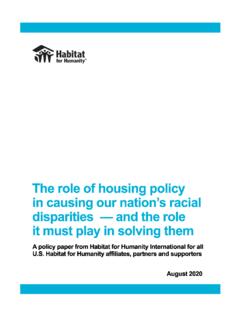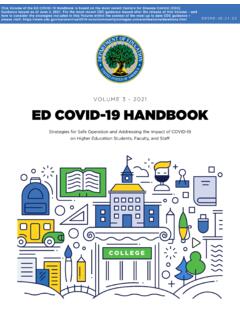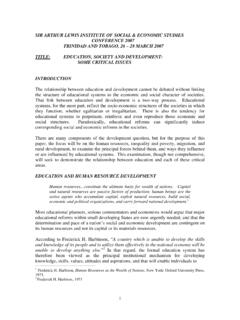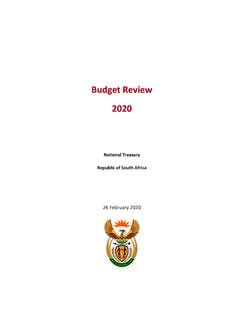Transcription of Defining and measuring disparities, inequities, and ...
1 Defining and measuring disparities , inequities, and inequalities in the Healthy People initiative Richard Klein MPH, David Huang, National Center for Health Statistics Centers for Disease Control and Prevention Four Concepts of Difference Disparity Inequity Inequality Burden Distinctions Among the Concepts Application to policy or Concept Research question program planning Disparity Is there a difference in health status Is the difference too large? rates between population groups? Inequity Is the disparity in rates due to Is the distribution of resources fair?
2 Differences in social, economic, environmental or healthcare resources? Inequality* How do rates vary with the amount of Can the distribution of the population the resource, and how is the among resource groups and/or the rates population distributed among within resource groups be influenced? resource groups? Burden How many people are affected in How many people would benefit specific groups and in the total from interventions? population? *Questions and applications refer to ordered groups The Concept of Disparity Disparity is the quantity that separates a group from a reference point on a particular measure of health that is expressed in terms of a rate, proportion, mean, or some other quantitative measure.
3 (HP2010). Disparity in Healthy People 2010. ( and implict value judgments*). disparities are measured from the most favorable group rate, (Preference for raising health among unhealthy groups). in terms of relative differences, (Equality valued over population health or rates of disease). with groups unweighted for size (Groups are of equal importance regardless of size). Disparity across domains is measured by average difference (Emphasis on reducing inequality regardless of how). *. *Based on Harper et al Implicit Value Judgments in the Measurement of Health Inequalities.
4 The Milbank Quarterly, Vol. 88, No. 1 (pp. 4 29). 2010. Infant Mortality Rates per 1,000 Live Births by Mother's education , US 2005. education RATE. 0-8 years 9-11 years 12 years 13-15 years 16 years or more Source: National Vital Statistics System (NVSS), CDC, NCHS. A difference in disparity . For example The infant mortality rate for mothers with 9- 11 years of education is infant deaths per 1,000 live births (or 121%) greater than the rate for mothers with 16. or more years of education . The Concept of Health Equity Health equity is the fair distribution of health determinants, outcomes, and resources within and between segments of the population, regardless of social standing.
5 Working definition from the CDC Health Equity Working Group, October 2007. The Concept of Inequity Inequity . A difference in the distribution or allocation of a resource between groups (usually expressed as group- specific rates). Resources relevant to health include: Health insurance education Flu vaccine Fresh food Clean air Percent of mothers with 12 or more years of education , by race/ethnicity, 2005. Race/Ethnicity Percent American Indian or Alaska Native Asian or Pacific Islander Hispanic Black non-Hispanic White non-Hispanic Source: National Vital Statistics System (NVSS), CDC, NCHS.
6 Inequity question: Are the racial/ethnic differences in infant mortality rates that we observe attributable to educational differences? Are those differences fair ? The Concept of Inequality Inequality . A measure of the degree of association between differences in rates between groups and the distribution of the population among groups It is a single value that represents The degree of association between rates for a health indicator and the distribution of the population among ordered groups ( education and income). -or- The degree of variation in rates among unordered groups, weighted by group size (race and ethnicity).
7 Educational inequality in infant mortality for white non-Hispanic mothers, 2005. 12. 10. Infant deaths per 1,000 live births 8. 6. 9-11 years 4. 12 years 13-15 years 16 years 16 years and and over over 2 0-8 years 0. 0 20 40 60 80 100. Cumulative percent of the population The slope index of inequality = The infant mortality rate declines by an average of infant deaths per 1,000 live births over this population, ordered by years of education . Source: National Vital Statistics System (NVSS), CDC, NCHS. Educational inequality in infant mortality for Hispanic mothers, 2005.
8 12. 10. Infant deaths per 1,000 live births 8. 6. 13-15 years 4. 16 years +. 0-8 years 9-11 years 12 years 2. 0. 0 20 40 60 80 100. Cumulative percent of the population The slope index of inequality = The infant mortality rate declines by an average of infant deaths per 1,000 live births over this population, ordered by years of education . Source: National Vital Statistics System (NVSS), CDC, NCHS. The Concept of Burden A difference in burden . The difference in the number of persons affected between groups. Generally, the larger the group the larger the burden.
9 Number of Infant Deaths by Mother's education , US 2005. education NUMBER. 0-8 years 1,145. 9-11 years 3,836. 12 years 6,747. 13-15 years 3,666. 16 years or more 3,231. Not stated 994. Source: National Vital Statistics System (NVSS), CDC, NCHS. A difference in burden . For example The burden of infant deaths is greatest for mothers with 12 years of education . Burden of infant deaths and reduction in burden, by race/ethnicity of mother, 2005. Reduction in burden Infant (number of infant deaths). deaths Burden If HP target per 1,000 (number of If disparities achieved with live births infant deaths) eliminated no change in Population by race and ethnicity disparity Non-Hispanic black 7,958 5,103 2,705.
10 American Indian or Alaska Native 361 142 123. Non-Hispanic white 13,134 1,985 4,464. Hispanic 5,537 718 1,881. Asian or Pacific Islander (best rate) 1,129 0 383. Total 28,119 7,948 9,556. Source: National Vital Statistics System (NVSS), CDC, NCHS. HP2010 objective: reduce the infant mortality rate to infant deaths per 1,000 live births Disparity/Inequity in Healthy People 2020. What was called disparity ( difference) in HP2010 is increasingly being called inequality . (Harper et al, Pokras et al). The concept of disparity in HP2020 is closer to previous conceptions of inequity: Health disparity: A particular type of health difference that is closely linked with social or economic disadvantage.

















